 |
Merry
Christmas Blues
Vegas Baby
A Beginner's Guide To Norway
Utepils And Flying Cats
I'm Not Hungry
MERRY
CHRISTMAS BLUES
Something strange happens at Christmas. It is a time of happiness, generosity, boozy parties and goodwill to all men, but indulging in this seasonal cheer has a high price. For some, it's wearing novelty reindeer antlers in public; for others, Santa ties or tinsel earrings. There's even the odd unfortunate who, in a haze of cheap sherry and even cheaper lager, thinks snogging all and sundry at the office Christmas do is the ideal way to spread some festive spirit (it's not). But by far the worst thing about Christmas is bad Christmas songs.
I'll admit Christmas records belong to a respectable musical sub-genre, but regardless of a song's merit, there's no excuse for playing it in October. Or November for that matter. These songs attempt to capture the festive spirit - which means they should not be played outside the 12 days of Christmas. Ideally, they should really only be played on Christmas day, preferably in the morning. Listening to them outside the hours of 9am and noon, say, is overdoing it.
The rules of Christmas songwriting are flexible, but for a song to be truly festive, they have to fulfil two criteria. There must be a tinkling of bells (sleighbells for preference) and the lyrics should include the word "Christmas". The best Christmas songs immediately conjure up happy memories - idyllic mornings spent in your pyjamas, a smear of chocolate on your cheek, playing with Lego amid a mountain of crumpled-up wrapping paper. But most are dire, dragging you back to those long, leaden hours after Christmas dinner, spent being interrogated by the scarier members of the family.
Possibly the worst Christmas song ever recorded belongs to Chris de Burgh, perpetrator of the truly terrifying A Spaceman Came Travelling. In it, de Burgh claimed Jesus was an alien. Worryingly, he sounded as if he meant it. Then there's Slade's Merry Christmas Everybody. This record is ubiquitous. So much so that I suspect the lyrics and melody will soon have their own genetic code. This isn't necessarily a good thing, familiarity has been known to breed contempt. There is something to be said for Mud's Lonely This Christmas, but I'm not prepared to say it. Who can tell whether it's preferable to Paul McCartney's execrable Wonderful Christmastime or Cliff Richard's bilious Mistletoe and Wine.
While Jethro Tull's Ring Out Solstice Bells is best left well alone, every home should echo to the strains of the Pogues and Kirsty MacColl's Fairytale of New York on Christmas morning. It takes those two most festive of emotions, rage and affection, and bundles them into an epic which should set the whole family up quite nicely for a spectacular row during the lull between turkey and pudding.
But there's a brighter side. There's Wizzard and I Wish it Could be Christmas Every Day. It's a good record, but Rock'n'Roll Winter's a better effort. Wizzard were led by Roy Wood, a painted-face druid of a man with more hair than humanly possible. Wood knew how to offer respect where it's due and he paid tribute to Phil Spector, the patron saint of Christmas music, with every note he played. A Christmas Gift For You From Phil Spector is, without doubt, the classic Yuletide album. Spector distilled the very essence of Christmas spirit into a little over 30 minutes of perfect pop. There's Darlene Love's sublime White Christmas, the Ronettes' sexily innocent rendition of Frosty the Snowman, the epic Silent Night. There are bells and everything.
Bobby Helms' Jingle Bell Rock is a safe bet for grandma and the toddlers, and so is Falling Joys' Little Drummer Boy - the pah-rum-pa-pa-pums are pretty fine - but, once the kids and gran are out of earshot, it's hard to go past Eartha Kitt purring through Santa Baby, possibly the most erotically charged Christmas record in existence.
You don't often hear Bing Crosby and David Bowie's Little Drummer Boy warbling out of shopping centre PAs during the extended Christmas shopping season, which is probably a good thing. This song only works when you can gaze, dumbstruck, at the video. Bing, just weeks away from death, looks like he's dreaming of the 19th hole. Bowie appears to have already left for a distant galaxy.
But the true spirit of Christmas is not white, but blue, as Elvis knew. For those who prefer to weep into their Christmas pudding, country and western offers up a rich seam of festive misery. Tammy Wynette's Christmas with Tammy is excellent, with a number of gloriously morose tunes which just happen to be set around December 25. Emmylou Harris's contribution is worthy as well, although she sticks to old favourites and while they sound mournful enough, it's cheating a little. Gene Autry achieved just the right amount of angst in Rudolph The Red-Nosed Reindeer, but Ernest Tubb, the king of honky tonk, is the master of Christmas misery. Tubb wore the finest Stetsons in Nashville, played Jimmy Rodgers' guitar and had a voice that sounded as if he had slipped off his bar stool. His White Christmas is nothing short of spectacular. He croons like a drunken uncle hula-ing to a symphony of Hawaiian guitars at James Stewart's Christmas party.
Low's Christmas is another gem, perfect in almost every way. The Minnesota miserabilists give you sleighbells and snow, a hint of bittersweet disappointment and a kick of child-like excitement in. Just Like Christmas is a masterstroke.
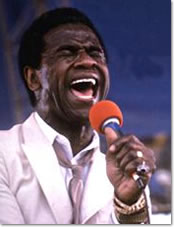
Al Green
The deepest recesses of Santa's grotto hide some other fine tunes - the Pretenders' 2000 Miles, Patti Smith's We Three Kings, songs from Al Green, Patsy Cline, even Harry Belafonte's Mary's Boy Child - but best of all is the Jackson Code's version of Have Yourself A Merry Little Christmas. It's spare, gentle and sweetly melancholy, wistful and softly optimistic in equal measure. And, to make up for the absence of bells, there's an awkwardly beautiful snippet of brass in the opening bars. It's the closing track on Del Musical del Mismo Nombre, released by Citadel. Buy it as a Christmas present to yourself.
© 2000 Anthea Pitt
::Index::
VEGAS, BABY
Need to give a sharp-suited mister the brush-off? There's a perfect, all-purpose retort. But there's a tale first.
Once every four weeks, Vegas comes to Edinburgh. A slick groove in a Georgian ballroom in the funky end of the New Town. Deep, deep red walls, velvet curtains hiding floor to ceiling windows, dusty repro Grecian statues in alcoves, mirror balls glittering from a high ceiling, a sprung dancefloor, you can lighten your roll of Elvis dollars in the Stardust "casino" at the bottom of the spiral staircase. The boys wear suits, the girls wear heels and the DJ sports the wildest afro this side of 1973.
It's cheesy, just the right side of sleazy and almost decadent. The only thing that's missing is the wiseguys.
When you're off to Vegas, do it in style. A cocktail or two, some good friends, killer heels, your most glamorous op-shop cocktail frock - add a slick of lipstick and you're ready for anything.
Even Edinburgh's answer to Dean Martin.
The next time Dino tries it on, look up sweetly and whisper demurely: "Bugger off, I'm dancing to Elvis."
Click to go to Vegas
© 2001 Anthea Pitt
::Index::
A BEGINNER'S GUIDE TO NORWAY
Moving countries is a tricky business - some do it for love, others for work, and there are still others who, like myself, are essentially restless souls with feet that itch so insistently that even a warehouse full of itchy foot powder can't soothe it.
It's odd then, that when it came to packing up, saying goodbye and pretending I was leaving grown-up life behind for the fourth or fifth time, rather than swanning off somewhere indescribably exotic, I headed for Norway.
Oslo to be precise. At first glance, it doesn't really make your soul sing, does it? The name hardly trips off your tongue and it doesn't deliver the same delicious frisson that you get from casually dropping Montevideo or Brazzaville into conversation. You tell people you're moving to Oslo and most want to introduce you to a really pleasant psychiatrist they once met at a party.
Oslo doesn't even have any obvious dangers. It's not as if I have to spend a few days every fortnight pleading with the local racketeer for a share of my salary, as one former colleague did during a stint in St Petersburg. I don't have to negotiate smouldering ruins and sniper fire to get to work, nor are Norwegian motorists as maniacal as say, your average Neapolitan taxi driver.
No, Norway's stolid, safe, social democratic, respectable. Norwegians are well-fed, well-clothed and well-off. Norway's normal.
But that's where you're wrong. Norway is the antithesis of normal. Norway takes surreal, puts it through a stainless steel Scandinavian-designed blender and redefines the word. The country pretends to be a sober, law-abiding, sane, peace-loving Scandinavian haven with as many Ikea outlets as Sweden, but it's not. It's simply that for years Norway's PR has been so good that we all believed it. (Actually, it might have more Ikea outlets than Sweden, so on that score perhaps the PR didn't lie.)
Thor Heyerdahl and his reed raft alone should prove that in Norway not everything is as it seems, but for the sceptics, let's examine things a little more closely.
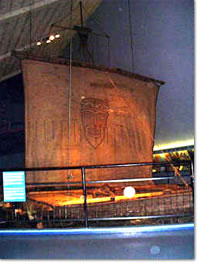
The Kontiki
First of all, Norwegians play soccer in summer. That's not the behaviour of a sane sports-loving country, is it? You could argue that perhaps -20C is a little too nippy for competitive sport, but what better way to keep hypothermia at bay than 90 minutes of hard and fast football? So teams in Tromso might have trouble training once the sun sets for 6 months, but if they were serious about their sport they could always try switching the stadium lights on. Besides, a little bit of black ice on the pitch would really make sliding tackles exciting.
Norway's cuisine also offers some pretty hefty clues to the country's inescapable madness. Icelanders may bury dead sharks for the better part of 3 months before eating them, but even they wouldn't consider lutefisk the stuff of an ideal Christmas dinner.
Lutefisk is cod which has been salted and soaked in lye - the stuff soap's
made from - before being washed out a bit, dried off and then boiled for hours
until it's a grey, fishy mush. It's delicious. Allegedly. And it's served for
Christmas dinner across the country. The other traditional Christmas meal is
pinnekjøtt - that's a big hunk of mutton which is ceremonially plonked on a
bundle of sticks before being boiled for 12 hours. If the lye doesn't get you,
the sticks will.
There's also raskefisk, which is similar to lutefisk, but far more dangerous. The thing about raskefisk is that it's more of an experiment than a meal. The whole idea is to serve salmon when it's just minutes away from becoming salmonella. Norwegians even throw raskefisk parties. Scary, isn't it?
The language hints at oddness as well. A kettle isn't a kettle in Norwegian,
it's a water cooker. A vacuum cleaner's a dust sucker. If you're unwell, you
get sent to the sick house. The fire brigade's actually a firing squad. A council
is a "ting" - that's thing in English. And the country's parliament? That's called the Storting - the "Big Thing".
Even people's names have a hint of the surreal. I once met a woman called Wenche,
pronounced Van-ker, but kept a straight face. But try stifling a laugh when
the introduction goes like this: "Hi, I'm Øivynd [pronounced "even"] and [indicating bloke next to him] he's Odd." Indeed.
Norwegians also take the idea of public ownership to an extreme. All the usual utilities and so on are state-run, but you find yourself scratching your head when you discover that Narvesen, the news agency chain, is owned by the state. There's also Tine, the state-run dairy products and packaging monopoly. And the supermarket chains buy all their stock from the government. This explains a lot, actually. Judging by the range of products on their shelves, your average Norwegian supermarket wouldn't look out of place in mid-1970s Novosibirsk. I'll get to the Vinmonopolet soon enough.

Vinmonopolet
But it's when you go out that you discover the true breadth of Norwegian insanity. The core of Norwegian madness lies in alcohol. The price of alcohol alone is insane - a pint of pils comes to roughly A$9 in an average bar, while having a dram or two of whisky is a one-way ticket to bankruptcy. There are ways around it though. All it takes is cunning, strategic thinking and a large dose of insanity.
A night out starts with deciding who's throwing the forspiel. Forspiel - and its later, darker, infinitely more frightening cousin, the nachspiel - are probably the only way to achieve proper Norwegian levels of drunkeness without having to take out a second mortgage. (And yes, the literal translations are foreplay and afterplay. The object of desire? Alcohol.)
Once you've chosen the venue for a forspiel - usually the home of a friend who has just returned from a holiday abroad and has stacks of untouched duty-free booze and fags - you haunt the supermarkets, looking for discounted beer, however oxymoronic that may seem in Scandinavia. Once you've found beer at a reasonable price, you have to act quickly and decisively. Be ruthless, there are at least 150,000 other souls stalking Oslo's Soviet-style supermarkets, hunting for an almost affordable six-pack or 12. If you find cheap beer, it's your duty to buy it all immediately. As I said, it's madness. Financial madness.
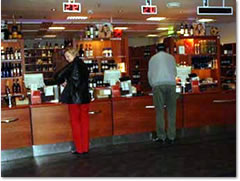
Inside the Vinmonopolet
Once you've secured a beer supply, you need wine and spirits. The cheat's way out is to go to Vinmonopolet - as the name suggests, it's the state-run wine monopoly and therefore the only place you can buy anything alcoholic that's not beer - but not only is this too easy, it's too expensive. There are some other drawbacks as well - you have to queue - for ages - to be served for a start. And you can't look at the bottles before you buy. You take a wee ticket from a machine, pick up your copy of Vinmonopolet's price list, wait your turn and make your choice. If you're really lucky, they'll actually have what you want in stock. It's catalogue shopping, but you do it on the premises rather than from home.

Take a ticket
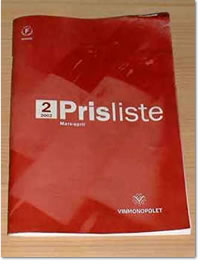
Check the price
To save the irritation and time-wasting of queueing at Vinmonopolet, you either do a run to Sweden - alcohol's roughly 33% cheaper there - or you build up a network of booze mules.
Norwegians have a reputation for being open and friendly and warm-hearted - they invite foreigners to Norway on the scantest acquaintance. While they are friendly, they're also doing it for the duty free. After a few months in the country, you're doing it yourself - you offer house space to every person you've ever met who lives outside Norway. They get a timeshare on the sofa in return for all the booze and cigarettes they can carry in without alerting customs. It's a fair swap - you bring in cut-price luxuries, I'll take you to a raskefisk party.
Now, once the alcohol's in place, all you have to do is drink it. Forspielen normally start as early as possible - you've managed to get your hands on alcohol, it'd be a crime not to drink it all before you go out. Besides, who can afford beer at club prices?
Once there's not a drop left in the house, you're ready to hit the streets. Literally. Norwegians have an uncanny ability to fall over in a drunken stupor without harming themselves. On a Friday or Saturday night, it's the only way you can tell Norwegians from ring-ins. Still, the few alcohol-free hours you've allowed yourself come in handy - once the band's done, you need to find a nachspiel.
Nachspiel follow a similar pattern to forspiel - you turn up at someone's house and drink everything they've got. Sometimes you even say thank you. Your best choice is to find someone who looks more sober than anyone you know, as the chances are they haven't got through their forspiel supply. Or you cultivate friends who are chemists. Chemists have access to industrial quantities of pure alcohol and spend their working hours diluting and distilling, working towards the holy grail of bootleggers - a perfectly drinkable moonshine. Incidentally, I have a sneaking suspicion that most Norwegians spend winter locked in their kitchens with a sack of potatoes and their great great grandfather's still, brewing away and rubbing their cold, chapped hands in anticipation of the nights of alcoholic oblivion that lie ahead.
Back to the matter at hand though. Oddly, because you're at a nachspiel with Norwegians you'll find that - miracle of miracles! - by about 5am you can speak Norwegian fluently. The Norwegians may not be able to understand you, but that's just because they're drunk. Remember, however, if you go to a nachspiel, you're under a constitutional obligation to come home after sunrise. At the earliest 10am. Anything before that is simply just not Norwegian.
And then? Wallow in the misery of a proper Norwegian-style Sunday.
A word of warning, however - don't even think of stopping in at the corner shop to pick up some paracetamol as you stumble home. You won't get any and the shopkeeper will immediately clock you as a foreigner. If you want to silence the tom-toms in your head, you'll have had to have gone to the state-run Apotek on Friday. Apoteken are the the only places you can buy anything vaguely medicinal. But don't worry, you get to take a wee ticket from the machine and queue for the legal maximum of 10 paracetamol. It makes it seem worthwhile. Incidentally, the term vaguely medicinal includes what are, in Britain and Australia, over-the-counter remedies for colds and hayfever, vitamin supplements and - this I find especially strange - veterinary medicines. Yep, Norwegian vets aren't allowed to dispense anything. In their surgeries, they can knock horses out with megadoses of ketamine, dose up your dog or cat with animal valium, carrying out intricate orthopaedic surgery on an anaeasthetised Fido, neuter your kitten or pup, but if your pet needs a course of antibiotics or ear drops, you'll have to go to the Apotek with a script.
Told you they were mad.
© 2002 Anthea Pitt
::Index::
UTEPILS AND FLYING CATS
It's spring in Oslo. There might be a nip in the air and the central heating's still on, but two things prove that the summer's not too far away: invitations for utepils and flying cats.
Neither of these are as strange as they sound.
Once easter is done with, Norway gets lighter and brighter. The clocks go forward and the sun sticks around for more than 3 hours a day. Norwegians unzip the outer section of their parkas, blink at the sun, yawn a little, stretch their limbs and rush to grab an outside table at their favourite bar. Winter's over - it's utepils time.
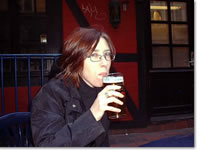
mmmmmmmm....utepils
Utepils - literally "out pils" - takes on an almost mystical quality if you've spent a winter in Norway. Even though it's only 4C and you have to hold your glass in a pair of woolly gloves, you're drinking to spending time outside, to the long, white nights and the mayhem summer brings. You can't escape utepils - your friends will invite you to have a first utepils, newspapers list the best places to go, some even estimate how many glasses of utepils were served over the previous weekend (about 350,000 if you're interested).
The first utepils of the year is almost as Norwegian as falling over drunk after celebrating Sweden's defeat at anything.
After the first few spring-like weekends, you learn there's an utepils racket in place - rather like the Parisian cafe owners' habit of charging you more for your coffee the farther away you sit from the counter, the more sun there is, the more expensive utepils seems to get.
Even the bars in the city's parks cash in on the Norwegian need to sit in the sun, drinking beer. Incidentally, these bars are usually owned by the local council - it's Scandinavia, the state has a duty to look after the needs of all its citizens. The one advantage of utepils in the park - and I'm not sure how much of an advantage this really is - is that it gives you the chance to observe northern Europeans behaving in a stereotypically northern European manner. Take a sunny day, add a patch of grass and a bar and soon you'll find a flock of northern Europeans lolling about in their swimming togs, working on getting sunstroke.
But spring's truly sprung when the cats start flying. It's not that Oslo's moggies sprout wings with the first crocuses, it's just that Oslo's a city of apartment buildings. With windowsills. And clumsy cats. I know this from experience - my cat is officially the first flying cat of the season. I sincerely hope the cats who follow in her pawprints are far more adept at taking wing than Jess, because, frankly, she was rubbish. If I were an expert at such things, I'd suggest she needs a few more hours of dual control flight before she attempts another solo trip.
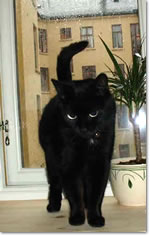
I can fly...
Regardless, the smiling young vets at the university's small animal hospital (or "poliklinikk" if you're after brushing up your Norwegian), seemed overjoyed to see a small, furry harbinger of spring. I guess it makes a change from frostbitten paws. They claimed that by the first week of May, all their feline patients are flying cats, after which the incidence drops off sharply. I didn't dare ask whether the decline in flyggekatten was down to natural attrition.
Spring also means it's time to spring clean. At some point in March, you'll get a wee letter from the body corporate of your apartment building, telling you that on such and such a date, at such and such a time, you can meet up with your neighbours, have some coffee and cake and then clean all the communal areas of the building. It might be worded as an invitation, but it's not. It's an order. And believe me, there's nothing quite so frightening as seeing a mob of Norwegians all working towards achieving a kitemark in Scandinavian Hygiene.
I think it has something to do with all that blonde wood. You can go to any Norwegian building - a friend's flat, an office, museums, anywhere - and there's not a speck of dust anywhere, the floors gleam, the windows sparkle. It's suspicious. Nothing's out of place. How can one small nation be so scrupulously clean?
It could be genetic - rather like the Norwegian ability to eat crispbread without either breaking noise pollution regulations or leaving chunks of crispbread down the front of their jumpers. An in-depth study was called for. I assembled a representative sample of Ordinary Norwegians - my flatmate, a friend's wife and the boyfriend.
My intensive research revealed that Ordinary Norwegians are manic about clean floors - in fact, they follow what a semi-independent expert (that's me, by the way) has dubbed the Norwegian 4-step Approach to Floors.
First, you sweep thoroughly, then you vacuum just in case you missed a bit, then you get one of those Swiffer things and wave it around a bit in a threatening manner to scare off any stubborn dust bunnies. Finally, you scrub. On your hands and knees, mind, none of that poofy Anglo mop business. And don't forget to give the door jambs a scrub either.
All three agreed that this was a normal approach to cleaning the floor and that anything less thorough would result in having a filthy house. In fact, my friend's wife suggested that floors should be tackled in this manner at least twice a week.
The Ordinary Norwegians also recommend this approach when cleaning bathrooms, though they were divided on whether dusting was more important than cleaning windows.
Oddly, the representative sample weren't quite so fussy about washing up. All three suggested that that's what dishwashers were for, adding that Australians were a touch obsessive about clean dishes and scrubbed benches. Touche.
© 2002 Anthea Pitt
::Index::
I'M NOT HUNGRY!
Norwegians are the human equivalent of a V8 engine. They might look good, they might rev up beautifully, once warmed up their engines might purr like a tiger - hell, if you pick your Norwegian carefully, they might even have mag wheels. But when it comes to fuel economy, a Norwegian doesn't do too many miles to the gallon.
When you first arrive here, you notice that most Norwegians lug rucksacks around all the time. "A-ha!" you might think, inadvertently alluding to one of Norway's exports. "Evidence of Norwegian practicality and their love of the great outdoors."
This might be partly true. There could be a spare pair of bushwalking boots and a compass in that rucksack, but I'd put my money on it being stuffed full of food.
You see, if a Norwegian doesn't follow a three-hourly feeding schedule, they get listless and slightly grumpy. If no food materialises, they start growing paler and paler before falling into a dazed semi-comatose state. In serious cases, they cease functioning until someone waves pølse under their noses.
To prevent this, it's best to have a steady supply of pølse (a saveloy-esque kind of sausage; possibly the Norwegian national dish) and crispbread at hand, just in case. There's nothing more disturbing than a hungry Norwegian.
It might be worthwhile to note that Norwegians - and their Scandinavian cousins - are probably the only people in the western world who can eat crispbread without developing a serious eating disorder. I used to believe that having a packet of Ryvita, Kavli or Wasa crispbread in your pantry was an indication of incipient anorexia. Not here. In Norway, cardboard-masquerading-as-food is a vital part of the daily diet.
I'm partially convinced that Norwegians eat simply to break the day into tiny manageable chunks. As I understand it, a daily feeding pattern goes something like this:
- 7am - breakfast.
- 10am - a wee snack to keep you ticking over until lunch.
- 11.30am - lunch.
- 2-2.30pm - smoko. Eat just enough to keep your blood sugar levels bubbling along nicely.
- 4pm - meet friends for coffee and cake after work.
- 5pm - pre-dinner nibbly bits.
- 6pm - dinner.
- 8-9pm - mid-evening munchies
.
- 12pm - midnight snack.
Of course, this isn't a rigid schedule and a normal Norwegian will probably try to graze a little between feeding times, just in case.
I find all this eating this vaguely problematic. It might be a cultural thing. I think the best way to explain it is to give you an example. Yesterday, a colleague asked me - at 11 - whether I was going down to lunch. I said no, much to my Norwegian colleague's surprised. He was silent for a while, and then asked in a slightly shocked and puzzled way why I wasn't eating. "Are you sick?" he said. When I said I wasn't hungry, you'd have thought I was sick. Not being hungry is no excuse to avoid a mealtime. In fact, to a Norwegian, it makes no sense at all. Apparently the whole idea is to eat so you don't ever get hungry.
© 2002 Anthea Pitt
::Index::
|